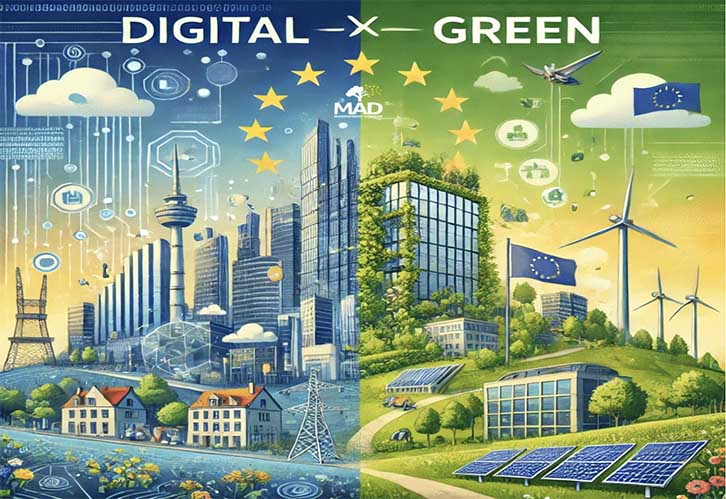Il fenomeno della twin transition, in Italia conosciuta come “doppia transizione” o “transizioni gemelle”, rappresenta uno dei capisaldi tematici su cui l’Unione Europea sta lavorando negli ultimi anni.
Infatti, in linea con l’agenda politica europea, il Quadro finanziario pluriennale (2021-2027) mira a investire su programmazioni ed azioni specifiche in settori d’intervento ritenuti fondamentali per l’innovazione e la competitività dell’Europa, e la doppia transizione digitale ed ecologica è senz’altro uno di questi. Un’importante accelerazione alla doppia transizione è stata data in fase post pandemica dal Parlamento e dalla Commissione Europea, fondando il rilancio del vecchio continente sullo sviluppo sostenibile (Green Deal) e sulla trasformazione digitale, al fine di contribuire a rafforzare l’autonomia strategica dell’Europa in vari settori specifici e di ricostruire la leadership europea a livello internazionale.
Doppia transizione digitale ed ecologica che si sostengono vicendevolmente e che agiscono, quindi, come vero e proprio motore dell’innovazione e della competitività europea.
Da un lato, la digitalizzazione e il progresso tecnologico investono tutti i settori dell’economia e della società, incidendo profondamente sugli stili di vita e contribuendo in maniera sostanziale alla sfida di un futuro sostenibile. Per riuscire nella transizione digitale, la ricerca e l’innovazione devono mirare a rafforzare l’autonomia dell’UE nelle catene del valore strategiche su scala globale e massimizzare i benefici tenendo conto dell’ampia varietà di contesti sociali, economici e territoriali in Europa.
Dall’altro lato, con il Green Deal non solo l’Unione s’impegna a rendersi climaticamente neutra entro il 2050, ma parallelamente investe in maniera significativa in ricerca e innovazione nei settori delle tecnologie pulite e delle politiche sociali, determinando di fatto l’efficacia con cui questa transizione avverrà e il relativo impatto.
Sulle transizioni gemelle si gioca il futuro dell’Europa nel medio e lungo termine e, pertanto, tutte le programmazioni europee a fondi diretti, e non solo, prevedono ingenti investimenti sulla doppia transizione nel settennio in corso, proprio perché impatta trasversalmente su tutti i settori economici e sociali. Tenendo conto della natura trasversale della doppia transizione, è possibile delineare in maniera sintetica e generica come essa venga trattata all’interno di alcuni tra i maggiori programmi europei, in base alle prerogative e agli obiettivi dei programmi in questione:
- Educazione e Ricerca – le transizioni digitale ed ecologica sono processi in corso, pertanto risulta necessario, qualunque sia l’ambito o il settore economico, sensibilizzare e formare su competenze verdi e digitali gli attori in gioco della cosiddetta “quadrupla elica”, che operano in prima linea nello sviluppo economico e quindi anche nel processo transitorio: enti di ricerca e di formazione, imprese, pubblica amministrazione e società civile. Su questo fronte, il programma Erasmus+ gioca un ruolo significativo, attraverso bandi che non solo sensibilizzano i gruppi target nel settore educativo e formativo, ma attivano anche processi sinergici e di cooperazione tra i rappresentanti della quadrupla elica, per un impatto efficace nel lungo termine. In ambito di ricerca, non si può prescindere dal più grande programma di ricerca e innovazione transnazionale al mondo, Horizon Europe, che tocca numerosissimi ambiti e settori economici e che coinvolge la quadrupla elica nella sua interezza. Horizon Europe dedica anche specifici bandi alla “twin transition”, sotto il Cluster 4 dedicato a Digitale, Industria e Spazio.
- Sostegno alle imprese – la doppia transizione è un tema rilevante anche per le imprese, che da specifici programmi ricevono supporto non solo in termini di trasferimento di competenze, ma anche in termini di aiuti economici (i cosiddetti fondi a cascata), volti ad incentivare e facilitare i processi transitori. Le imprese beneficiarie rivestono qui il ruolo di terze parti e si rivolgono a consorzi vincitori di progetto per ricevere fondi appositamente destinati a loro. Un esempio di programma europeo a sostegno delle imprese è il Single Market Programme, che riguarda il mercato unico, la competitività delle imprese, comprese le PMI.
- Cooperazione interregionale e transfrontaliera – le transizioni gemelle possono costituire anche un’occasione per attivare processi di cooperazione interregionale e transfrontaliera con relativo trasferimento di competenze in ambito green e digitale. Vastissimo programma europeo per la cooperazione tra diverse aree geografiche all’interno dell’UE e con le frontiere orientali e meridionali, è l’Interreg che, essendo uno strumento della Politica di Coesione dell’UE, ne porta avanti le prerogative fondamentali, tra cui la doppia transizione e l’inclusione sociale. Qualora i Paesi cooperanti siano di aree aventi sviluppo economico di diverso tenore, come i Paesi dell’UE e quelli del nord Africa e Medio Oriente, si può optare per un trasferimento di competenze dai Paesi più sviluppati a quelli meno.
E’ evidente che l’Europa sta andando in questa direzione e che, nel settennio in corso, molti dei suoi investimenti saranno incentrati sulla doppia transizione, ma chiaramente occorre agire anche su fronti paralleli. In ambito tecnologico, occorre creare l’ambiente infrastrutturale necessario, a partire dall’accesso a Internet ad alta velocità per tutti, garantire l’interoperabilità tra i dispositivi, includere le PMI tanto quanto le grandi aziende, puntare su una maggiore qualificazione della forza lavoro. Per quanto riguarda i requisiti ambientali, invece, occorre procedere con processi di sensibilizzazione e creare un ecosistema normativo che fissi standard ecologici elevati.

